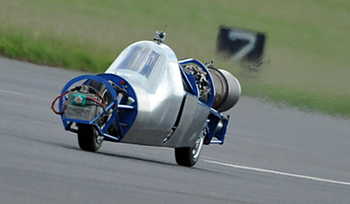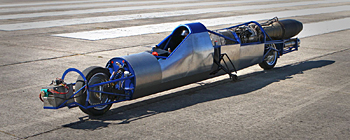Motorcycle land speed record research
Tue, 16 Oct 2012 11:17:00 BST
University experts help to green light the record-breaking 425mph Jet Reaction bike
 RESEARCH at the University of Huddersfield could help ensure that a daring Briton soon becomes the fastest man on two wheels, reaching speeds of 425 mph and beyond.
RESEARCH at the University of Huddersfield could help ensure that a daring Briton soon becomes the fastest man on two wheels, reaching speeds of 425 mph and beyond.
Richard Brown is determined to wrest back the world motorcycle land-speed record for Britain with his machine Jet Reaction, powered by an afterburning jet based on a helicopter engine (pictured being tested at RAF Benson).
It develops massive power but has taken the team behind the project into new scientific and technological territory. How will a jet-powered two-wheeler behave at such speeds? The Jet Reaction engineers decided that in addition to their own aerodynamic tests they would call on experts with special expertise in flow science.
So they contacted Professor Rakesh Mishra of the University of Huddersfield and he agreed to carry out a detailed aerodynamic investigation of Jet Reaction. For this, he enlisted PhD researcher Taimoor Asim (pictured below), who is a specialist in the increasingly important field of Computational Fluid Dynamics (CFD).
 Richard Brown furnished Taimoor with computer files containing the design and the dimensions of Jet Reaction, and the Huddersfield researcher spent three months carrying out a detailed analysis of the ways in which air would flow around the elongated machine, with its specially-designed nose cone.
Richard Brown furnished Taimoor with computer files containing the design and the dimensions of Jet Reaction, and the Huddersfield researcher spent three months carrying out a detailed analysis of the ways in which air would flow around the elongated machine, with its specially-designed nose cone.
It was a complex task that needed the full power of a 12-core computer newly available to Taimoor.
“At such a high speed as 425 mph, the air becomes compressible. Modelling of compressible flows using Computational Fluid Dynamics is quite challenging,” said Taimoor.
“Jet Reaction wanted to know if they would be able to attain that speed and if there are any safety risks involved. At such speeds, will the bike be stable enough?”
Taimoor ran a long series of computer simulations and found the project fascinating and valuable. It gave him a chance to investigate the effects of compressibility of air on the aerodynamic behaviour of a motorbike.
 When the project was completed, the results were sent to Richard Brown. The University of Huddersfield researchers were then told that their data, using CFD techniques, was a close match to the experimental findings of the Jet Reaction team.
When the project was completed, the results were sent to Richard Brown. The University of Huddersfield researchers were then told that their data, using CFD techniques, was a close match to the experimental findings of the Jet Reaction team.
“We were very pleased to hear that!” said Taimoor.
Jet Reaction has paid tribute to the University of Huddersfield's work: “When designing a vehicle to travel at very high speed, although aerodynamic principles are incorporated at the initial concept, it is essential to verify the principle applied.
“The main aim of this report was to analyse the aerodynamic effect on Jet Reaction as it reaches its target speed of 425 mph. This excellent report has verified the design and allowed Jet Reaction to continue to the next phase of manufacturing the bike.” (see more on Taimoor's research in the video below)
Taimoor Asim, aged 27, was born in Lahore, Pakistan, and did his first degree there before coming to Huddersfield and scoring a distinction for his MSc in automotive systems. After two years lecturing in his home city he took up an opportunity to return to the University of Huddersfield for PhD study supervised by Professor Mishra.
He is full of praise for his supervisor: “Professor Mishra’s expertise in fluid dynamics really helped me a lot in understanding compressible flow phenomena,” says Taimoor. Taimoor also praises the environment and the facilities at Huddersfield and is keen to do further research once his PhD, now in its final year, is completed. Computational Fluid Dynamics is becoming vital in a wide range of industries, including oil and gas.
- Richard Brown, of Jet Reaction, has a long history of breaking and challenging for land speed records. In 1999, at the famous Bonneville Salt Flats, he achieved the fastest one-way speed ever recorded, riding a rocket-powered bike at 365 mph. This record stood until 2006 when it was pipped by two American teams. Determined to get the record back, he decided to switch from rocket to jet propulsion and now his new machine has undergone low speed tests at British airfields and the goal is to go for the speed record next year, with the likeliest venues being Bonneville or Verneukpan in South Africa (http://www.jetreaction.net/).







